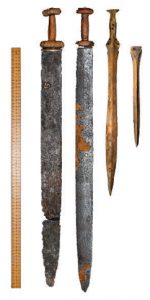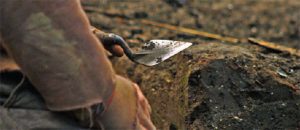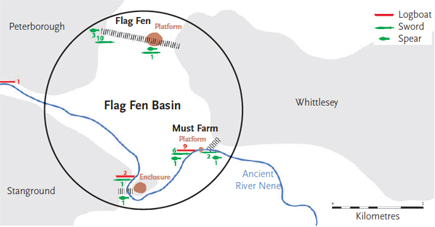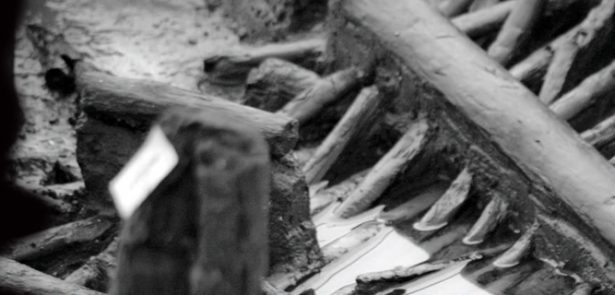Considered one of the most important Bronze Age sites in Europe, excavations at Must Farm in Whittlesey have revealed more about what life was really like for our ancestors living 3,000 years ago than ever before – as well as casting new light on the discoveries open to visitors at Flag Fen, just two miles away. And those surprises just keep coming. As a new, free exhibition at Vivacity’s Peterborough Museum puts some of these amazing artifacts on show for the very first time, The Moment talks to Vivacity’s Julia Habeshaw, curator of the exhibition, and Mark Knight, lead archaeologist on the Must Farm investigations
Big premieres are a rarity in Peterborough, but this May sees an event whose significance surely knocks Hollywood glitz into a cocked hat: the first display of objects from a once-powerful culture, many of which have not been seen publicly for over three millennia.
Must Farm first made big news in 2011, when archaeologists investigating an old quarry pit unearthed a wealth of Bronze Age artefacts. ‘In 1999 an upright timber was found at the quarry near Must Farm,’ explains Vivacity curator Julia Habeshaw. ‘It was similar to those forming the huge Bronze Age causeway at our site at nearby Flag Fen, so it was known then that there was something there. Experimental trenches were dug in 2004 and 2006, then there was the river channel dig, which turned up the incredible – and now very famous – log boats, as well as elaborate fish weirs and fish traps.’
There were also personal items such as swords and pottery – and not just two or three log boats, but nine. According to lead archaeologist Mark Knight, who has been excavating the area with a team from Cambridge Archaeological Unit, the sheer profusion of finds at the ‘river channel’ caught them completely by surprise.

The team recovered personal items, such as swords and pottery
‘Every time we looked at that channel and those sediments, it turned up log boats, swords, spears, settlements. It’s busy and its rich, so if we went 30km downstream or further into the fens, would we find the same? Those are the implications.’
A more recent dig about 1km from the first certainly seems to support this idea. In 2015/16, the ‘platform settlement’ dig uncovered a complex of five stilted roundhouse dwellings which had been destroyed by a catastrophic fire.
‘The settlement is over the water and is built within what appears to be a defensive palisade on the waterway,’ says Julia. ‘Perhaps it has been built to control boats going in and out, regulating commercial activity.’ This commercial activity involved trade that stretched as far as the continent. These are clearly wealthy, powerful and capable people – but it seems they may also have had enemies.
‘A panel of experts has looked at the way the fire took hold and there’s no evidence to suggest an accident, so they think it may have been a deliberate attack. In some ways it seems quite an egalitarian society, because all the huts are the same size. But it wasn’t a utopia; there’s a lot of weaponry, so clearly there was also violent conflict. What this small cluster of huts had to say about daily, family life during the Bronze Age was extraordinary.
‘With the platform excavation we have context – floors, walls, everything really,’ says Mark Knight. ‘People see the site as being very special, which obviously it is archaeologically, but in a way we’re trying to counteract that – to suggest that this is a glimpse of their normal, everyday world, not a strange anomaly. It allows us to see day-to-day living with incredible clarity.
This new discovery was soon dubbed ‘Britain’s Pompeii’, not just because of its sudden fiery demise, but because of the extraordinary richness and state of preservation of the findings – due in part to the rapid evacuation of the doomed buildings, during which almost everything was left behind.
‘Each roundhouse has its own array of kitchenware, utensils and tools,’ says Julia Habeshaw – who herself trained as an archaeologist, and has co-authored a guidebook (with Sarah Wilson) on nearby Flag Fen, with which the Must Farm sites are closely connected.

The dig uncovered an immensely rich array of evidence
‘The Must Farm excavation went far beyond anyone’s expectations with what it revealed about everyday life in the Flag Fen basin. The Bronze Age is a very long time ago, and the evidence that we have from it is usually sparse. But here, we’ve got an immensely rich array of evidence – things that normally would not survive – which gives us an incredibly vivid and rare glimpse into the lives of people in that period, and also how significant this area was as a centre of trade. It really is quite incredible, which is why it was voted the best archaeological excavation of 2016 in the British Archaeological awards.’
Amongst the discoveries so far have been a complete wooden wheel – the oldest ever found in Britain – and pots that still contained food over 3,000 years after they were lost. Historic England, who commissioned the excavation, which is also part funded by the quarry firm Forterra, found extra money when the dig had to be extended twice as objects continued to pour out of the mud. So perfect is the state of preservation at times that, according to Mark Knight, it’s almost uncanny.
‘The fish traps look like they could still catch fish, the fish weirs look like they’re still set to funnel the fish into the traps, the boats look like they’re moored. There is a Marie Celeste feel about it. It feels like the only thing missing is the people themselves. It doesn’t feel like archaeology!’
When asked about standout moments during the excavation, Mark struggles. There are just too many. But one occasion sticks in his mind – not because it was outlandish, but precisely because it was so ordinary. ‘We came across a great big storage jar, about 60cm tall and 40cm in diameter. Heather, who was excavating it, cleaned it up and recorded it. Because it was partly broken she was able to lift shards away, and as she did so she found another, smaller storage vessel inside. So she cleaned and recorded that, and then when she started talking that away there was an even smaller one inside that! So, three vessels nested together, just as they might be in your kitchen cupboard. That told me we were dealing with something that was in some ways very familiar and which was going to give us a faithful impression of what daily life was like 3,000 years ago. But that’s really the story of the excavation – just when you think you know what you’ve got, there’s something more.’
This incredible state of preservation is largely due to the unique wetland conditions found here. ‘The sediment that covered the finds is very slow forming and gentle – it’s all silt or peat, there’s no erosion, and it also gets in between things, so everything remains in articulation. Most sites on dry land are compressed or eroded, but here you get the full verticality of everything. You feel like you’ve gone from being a two-dimensional archaeologist to a three-dimensional archaeologist, with things in much clearer relationship. That changes the whole approach.’

Map of the area and significant points of discovery
There is also the specific chemistry of the sediment which prevents much organic material – such as wood and textiles – from decaying. ‘Things that don’t survive on dry land are present here in abundance, with every layer richer than the last. That can be a bonus, but it’s also a headache in that you can barely move for materials! You feel like you just turned up a few weeks too late to meet the people, rather than 3,000 years having passed. When you peel the sediment away you get bits of wood that look like they were held yesterday – beautiful yellows and pinks and browns. They start to decay before your eyes, but you do feel this strange collapsing of time.’
Cambridge Archaeological Unit is still analysing many of those materials from the platform settlement, and even those that have been analysed are going through conservation. ‘We came off site last August and we’re going to be drawing out the latent detail from those artefacts for the next three years. But with the early channel excavations from 2009- 2012, most of that analysis is now done and we’re at a point where we have an understanding of that landscape. So, the exhibition focuses on that, earlier story of the channel.’
This part of the story, relating to the river channel, is around the middle Bronze Age – about 1600 to 1300BC. ‘This was when the river was a deep river and there were field systems around Bradley Fen,’ say Mark. ‘We don’t see much evidence of settlement, but there is a lot of fishing activity, with fish traps and fish weirs and lots of log boats going up and down, with bits of metalwork being deposited into it. It’s that kind of world.’
“There is this enormous causeway – an incredibly long raised wooden walkway. It has a practical function, going from one area of dry ground to another, but it also has this massive platform in the middle of it – the size of Wembley Stadium!”
By the time of more recent pile-dwelling excavation – which belongs to 1300 to 800BC – the waters have risen. ‘Here we’re looking at a channel that is very shallow, that is silted up and more like a lake with lots of adjacent channels, but with many more signs of occupation. People seem to have made a conscious decision to move out onto those waters. So, the period the exhibition is about is a time when people are living on land but crossing water, and using the rivers as routeways and to fish in, while the next phase of that story is about people actually living on the rivers and settled in the wetlands. The Flag Fen Causeway bridges both those stories. Quite literally!’
‘At Flag Fen there were no dwellings found, even though we have a reconstructed roundhouse there,’ explains Julia. ‘But there is this enormous causeway – an incredibly long raised wooden walkway. That has a practical function, going from one area of dry ground to another, but it also has this massive platform in the middle of it – the size of Wembley Stadium – and most of the finds from there suggest ritual practices. This is from an earlier date than most of the findings at Must Farm, although they have found timbers there which match the date of the Flag Fen causeway timbers, so there is a continuity between these two sites.’
Both are keen to emphasise the continuity and connectedness of Flag Fen and the twoMust Farm sites, all of which have the potential to shed light on each other. Mark explains: ‘The way that we talk about our landscape when in the field or writing up our material is that it is the Flag Fen Basin, with its relationship to the Nene and that whole sense of a wetland landscape. The reason they built a causeway at Flag Fen is the same reason they built at Must Farm, so it’s that relationship; there are things going on at our site that often went on at Flag Fen and vice versa.’
The exhibition will help to bring all these strands together – as well as giving local people first glimpse of some of the extraordinary objects that put the area in the national and international news so many times over the past five years. Julia says: ‘We have many objects from the river channel excavations that have never been on public display before which are really amazing, including swords that were placed into the river – probably as ritual deposition. There are larger Iron Age swords as well as Bronze Age ones, which show, like the boats, that this part of the river was a special place for a long period of time.’
There will also be an item from the more recent excavations at the platform settlement – a pot preserved with its spoon and still containing food. It’s the first time this and the swords have been seen anywhere in the world. In addition to the objects themselves there will be photographs, CGI, film and other interpretation which will bring the finds to life, as well as a series of associated events. ‘I think people will really be able to get a lot out of the stories behind the objects – and the stories behind the excavations,’ says Julia. ‘The opportunity to show these finds in Peterborough Museum, so close to where they were found, is really fantastic.’’
